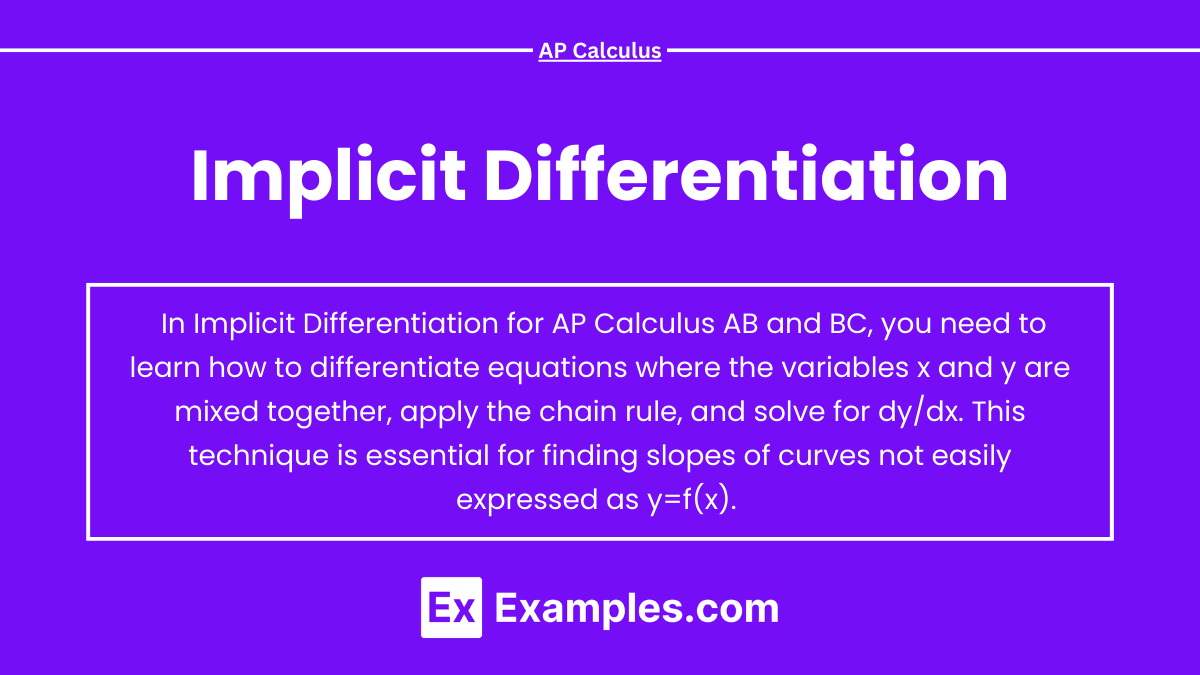Implicit differentiation is a calculus technique used to find the derivative of an equation where the dependent variable y is not isolated. Unlike explicit differentiation, where y is expressed solely as a function of x, implicit differentiation allows us to differentiate equations that involve both x and y interdependently. This method is essential for solving problems involving complex curves, tangent lines, and related rates, especially when the relationship between variables is not easily separable. It's a fundamental tool in both AP Calculus AB and BC.
Free AP Calculus AB Practice Test
Free AP Calculus BC Practice Test
Learning Objectives
When studying Implicit Differentiation for the AP Calculus AB and BC exams, you should focus on learning how to differentiate equations where y is not explicitly solved for in terms of x. Master the application of the chain rule in implicit differentiation, and be able to solve for dy/dx. Apply this technique to find slopes of tangent lines, solve related rates problems, and work with complex functions. In AP Calculus BC, also understand its application in parametric equations and polar coordinates.
What is Implicit Differentiation?
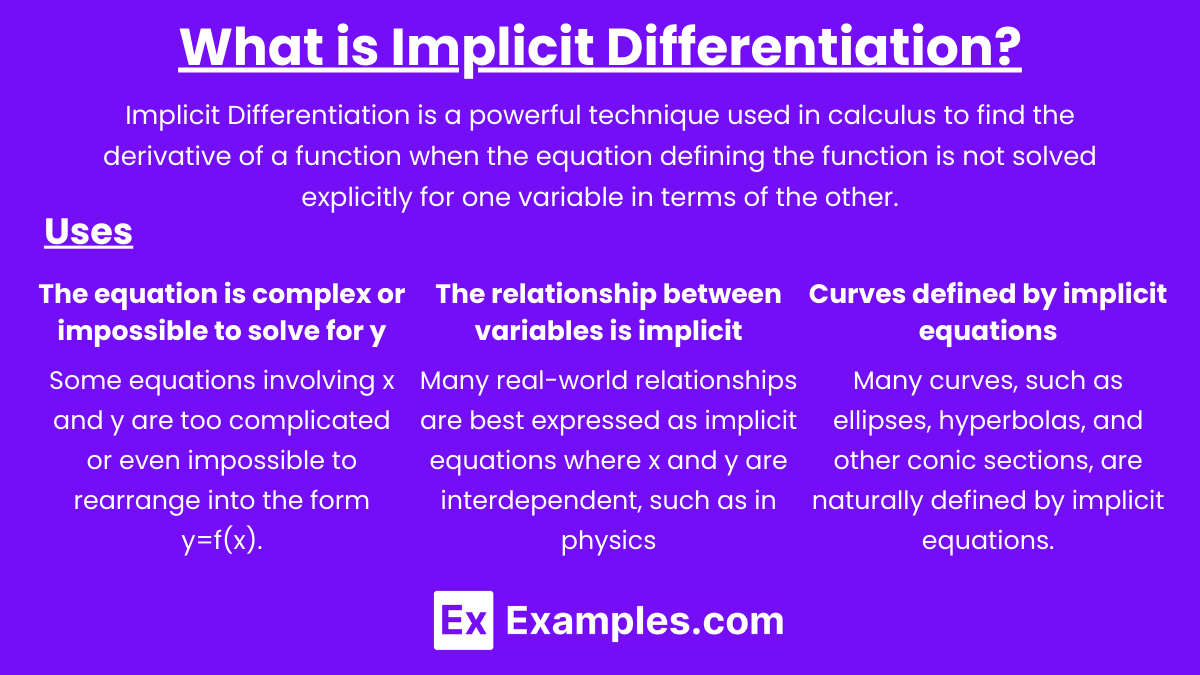
Implicit Differentiation is a powerful technique used in calculus to find the derivative of a function when the equation defining the function is not solved explicitly for one variable in terms of the other. In simpler terms, when y is not isolated on one side of the equation, and both x and y are mixed together, we use implicit differentiation.
This method is particularly useful when dealing with curves that cannot be expressed as a simple function y=f(x). Instead, the relationship between x and y is given implicitly, as an equation like F(x,y)=0.
Why Use Implicit Differentiation?
Implicit differentiation becomes necessary in various situations, particularly when:
The equation is complex or impossible to solve for y: Some equations involving x and y are too complicated or even impossible to rearrange into the form y=f(x). For example, the equation x2+y2 = 1 (the equation of a circle) cannot be easily solved for y in terms of x without losing generality or introducing multiple cases.
The relationship between variables is implicit: Many real-world relationships are best expressed as implicit equations where x and y are interdependent, such as in physics and engineering problems where variables are related in non-explicit forms.
Curves defined by implicit equations: Many curves, such as ellipses, hyperbolas, and other conic sections, are naturally defined by implicit equations. Implicit differentiation allows us to find the slope of the tangent line (the derivative) at any point on these curves without explicitly solving for one variable in terms of the other.
Implicit vs. Explicit Differentiation
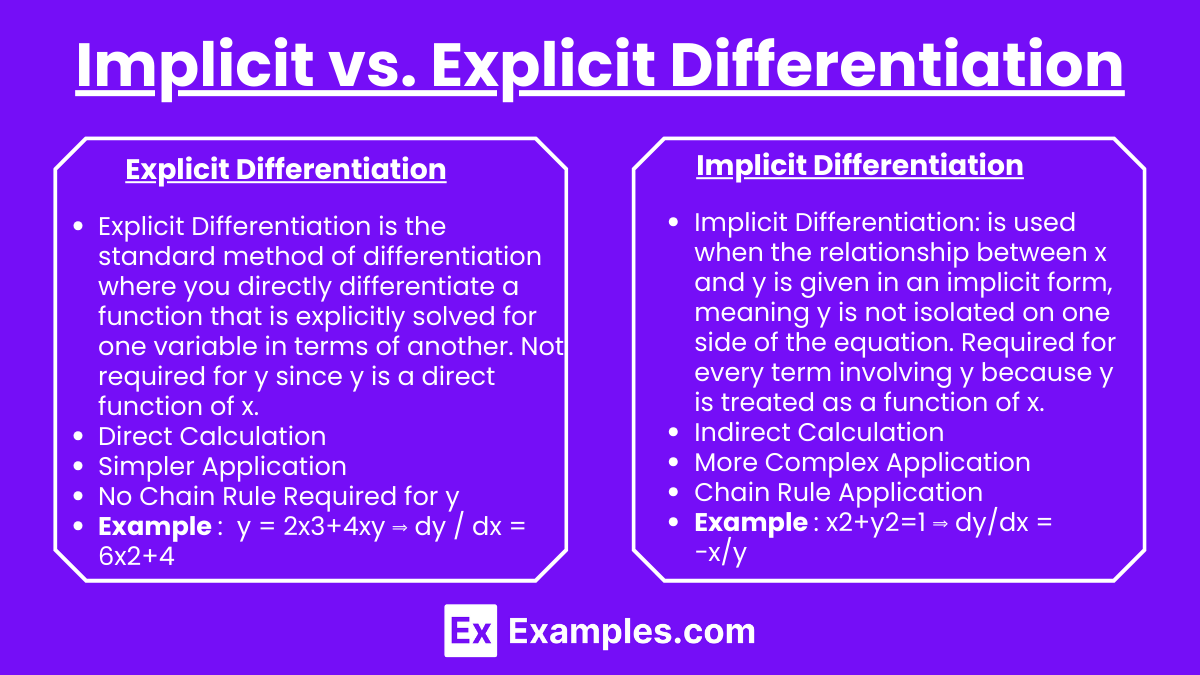
Implicit Differentiation and Explicit Differentiation are two methods used in calculus to find the derivative of a function, but they apply in different scenarios and involve distinct approaches. Understanding the differences between these methods is crucial for solving a wide range of calculus problems.
Aspect | Explicit Differentiation | Implicit Differentiation |
|---|---|---|
Function Form | Function is explicitly solved for y in terms of x (e.g., y=f(x)). | Function is not solved for y; x and y are intertwined (e.g., F(x,y)=0). |
Differentiation Process | Differentiate directly with respect to x. | Differentiate with respect to x, applying the chain rule to terms involving y. |
Complexity | Generally simpler and more straightforward. | Can be more complex due to the involvement of the chain rule and sometimes product or quotient rules. |
Use of Chain Rule | Not required for y since y is a direct function of x. | Required for every term involving y because y is treated as a function of x. |
Example | y = 2x3+4xy ⟹ dy / dx = 6x2+4 | x2+y2=1 ⟹ dy / dx = −x/y |
Explicit Differentiation : Explicit Differentiation is the standard method of differentiation where you directly differentiate a function that is explicitly solved for one variable in terms of another. In this case, the function is typically written in the form y = f(x), where y is isolated on one side of the equation, and its derivative can be computed straightforwardly.
Key Characteristics of Explicit Differentiation:
Direct Calculation: You differentiate y directly with respect to x since y is already expressed as a function of x.
Simpler Application: It is usually easier and more straightforward to apply because the function is explicitly solved for y.
Examples:
For y = x2, the derivative is dy/dx = 2x.
For y = sin(x), the derivative is dy/dx = cos(x).
No Chain Rule Required for y: Since y is already a function of x, the chain rule is not needed in this process.
Implicit Differentiation: is used when the relationship between x and y is given in an implicit form, meaning y is not isolated on one side of the equation. In this case, both x and y are mixed together, and you must differentiate each term with respect to x while treating y as a function of x.
Key Characteristics of Implicit Differentiation:
Indirect Calculation: You differentiate each term of the equation with respect to x, applying the chain rule to terms involving y.
More Complex Application: It involves a more sophisticated approach, often requiring the use of the chain rule and sometimes product or quotient rules.
Examples:
For the equation of a circle x2+y2=r2, the derivative is found by differentiating both sides with respect to x, resulting in dy/dx = −x/y.
For the equation x2y+sin(y)=x, implicit differentiation is necessary to find dy/dx.
Chain Rule Application: The chain rule is applied to every term involving y because y is considered a function of x.
How to Perform Implicit Differentiation
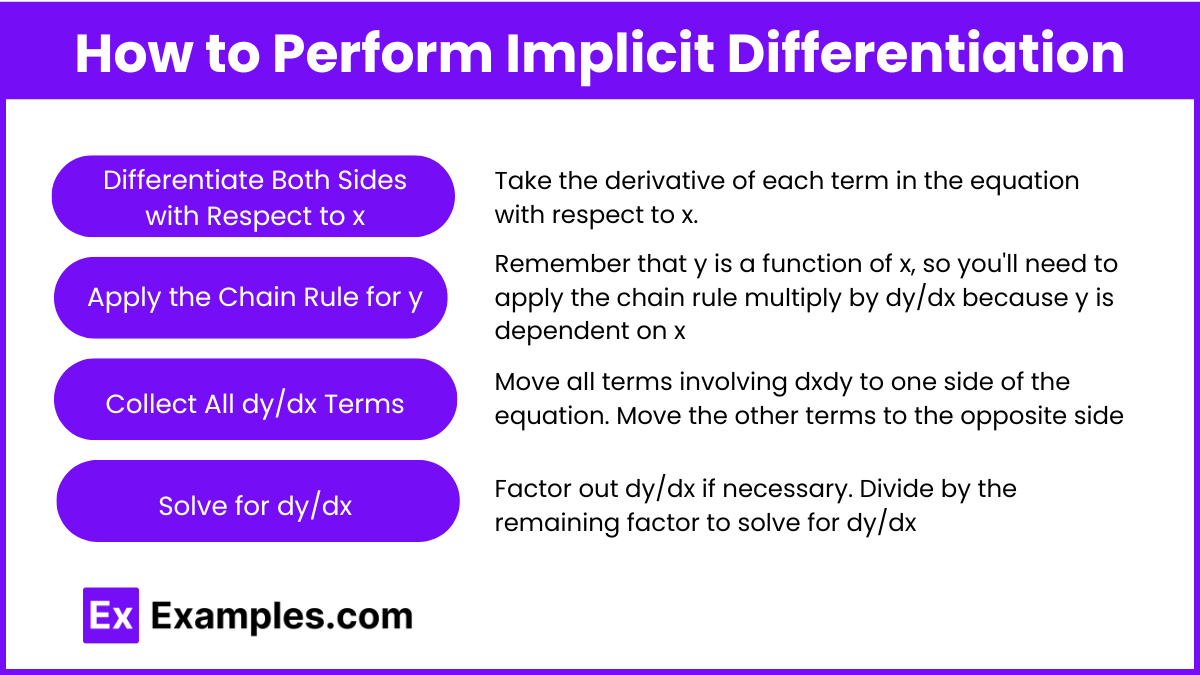
Differentiate Both Sides with Respect to x:
Take the derivative of each term in the equation with respect to x.
Remember that y is a function of x, so you'll need to apply the chain rule when differentiating terms involving y.
Apply the Chain Rule for y:
When you differentiate a term with y, multiply by dy/dx because y is dependent on x.
For example, if the term is y2, the derivative will be 2y⋅dy/dx.
Collect All dy/dx Terms:
Move all terms involving dxdy to one side of the equation.
Move the other terms (those not involving dy/dx) to the opposite side.
Solve for dy/dx:
Factor out dy/dx if necessary.
Divide by the remaining factor to solve for dy/dx , which gives you the derivative.
Real-World Applications of Implicit Differentiation
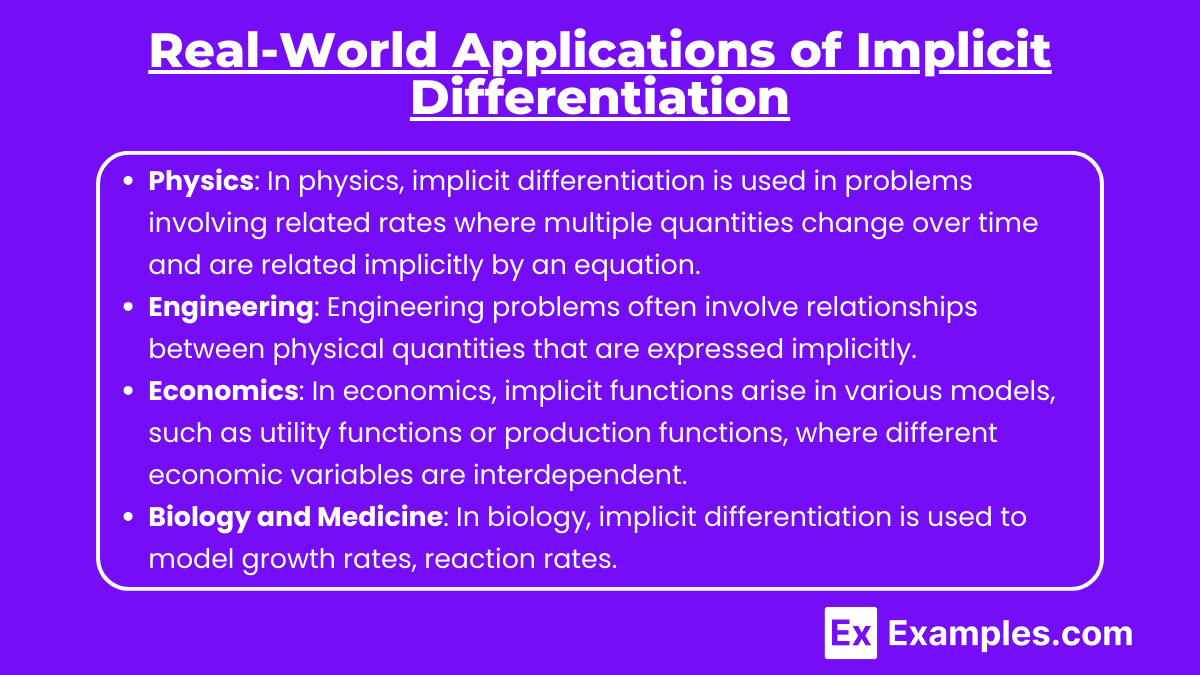
Implicit differentiation is not just a mathematical tool but also has practical applications:
Physics: In physics, implicit differentiation is used in problems involving related rates where multiple quantities change over time and are related implicitly by an equation.
Engineering: Engineering problems often involve relationships between physical quantities that are expressed implicitly. For instance, in thermodynamics, relationships between pressure, volume, and temperature are often modeled using implicit equations.
Economics: In economics, implicit functions arise in various models, such as utility functions or production functions, where different economic variables are interdependent.
Biology and Medicine: In biology, implicit differentiation is used to model growth rates, reaction rates, and other processes where multiple variables are interrelated in complex ways.
Examples
Example 1: Differentiating a Circle's Equation
Consider the equation of a circle: x2+y2 = 25. To find the derivative , differentiate both sides with respect to x.
This gives . Solving for ,
we get:
This result is the slope of the tangent line to the circle at any point (x,y).
Example 2: Differentiating an Ellipse's Equation
For the ellipse given by 4x2+9y2 = 36, differentiate implicitly with respect to x:
Simplifying,
we obtain . Solving for :
This derivative represents the slope of the tangent to the ellipse at any point (x,y).
Example 3: Differentiating a Hyperbola's Equation
Consider the hyperbola xy = 12. To differentiate implicitly, apply the product rule:
This simplifies to , and solving for gives:
This derivative provides the slope of the tangent line to the hyperbola at any given point.
Example 4: Differentiating a Trigonometric Relationship
For the trigonometric equation sin(xy) = x+y, differentiate both sides implicitly:
Expanding and rearranging to solve for gives:
This equation describes the rate of change of y with respect to x for the given trigonometric relationship.
Example 5: Differentiating a Logarithmic Equation
For the equation ln(xy) = x−y, differentiate implicitly with respect to x:
Simplifying and solving for yields:
This derivative expresses the slope of the curve defined by the logarithmic relationship at any point (x,y).
Multiple Choice Questions
Question 1
Given the equation x2+xy = 12, what is using implicit differentiation?
A)
B)
C)
D)
Correct Answer: B)
Explanation: Differentiate both sides of the equation x2+xy = 12 with respect to x:
Simplify and solve for :
So, the correct answer is B.
Question 2
If x2y+y2=10, which of the following is the correct derivative ?
A)
B)
C)
D)
Correct Answer: A)
Explanation: Differentiate both sides of the equation x2y+y2=10 with respect to x:
Solve for :
So, the correct answer is A.
Question 3
For the equation xy=5, what is using implicit differentiation?
A)
B)
C)
D)
Correct Answer: B)
Explanation: Differentiate both sides of the equation xy = 5 with respect to x:
Solve for :
Thus, the correct answer is B.

